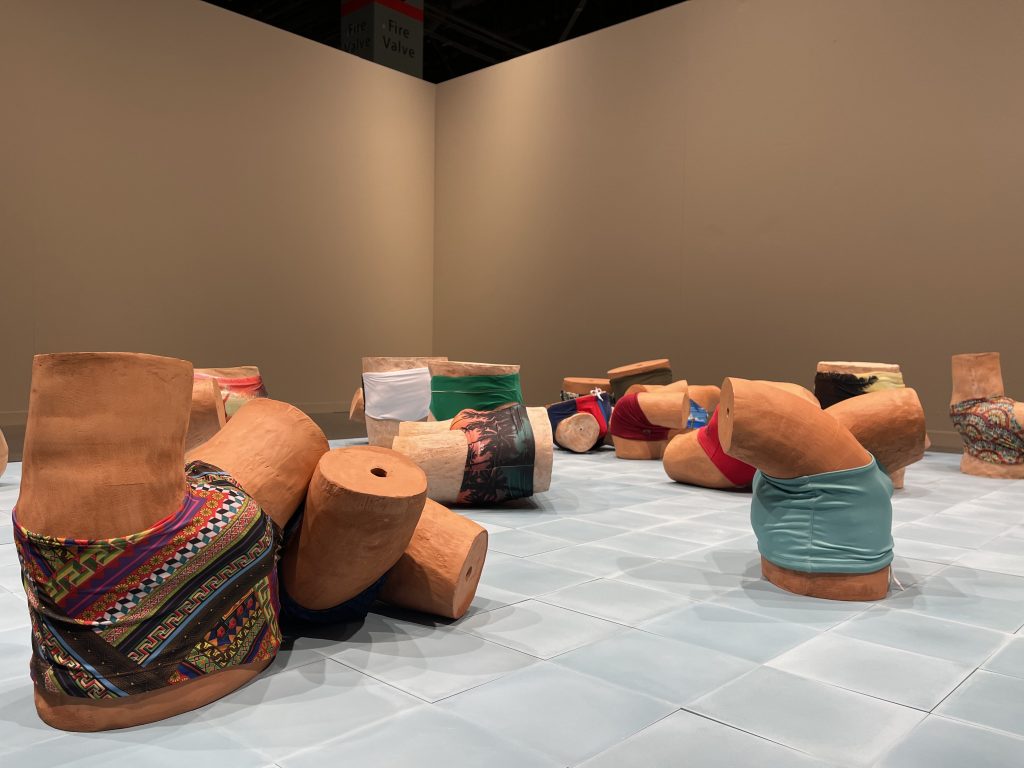Miami Art Week 2016: Chaotic Landscapes
Paintings and sculptures across a few fairs that dizzy with their complexity

Landscape imagery has long factored into the world of art and captivated viewers either by way of accuracy or interpretation. While searching the halls of the numerous art fairs that compose Miami Art Week, an abundance of impactful, chaotic landscapes became visible. Some of our selections are easily recognizable as a landscape image; others offer hints by way of color or form. All of them reveal tremendous complexity and arguably a greater message. The following eight works barely touch upon the breadth and depth of chaotic landscapes we witnessed, but in each we found something compelling and transportive.

Richard Mosse’s “Idomeni Camp, Greece” (2016)
Arguably the most important of all chaotic landscape pieces we viewed, “Idomeni Camp, Greece” by photographer Richard Mosse captures a refugee camp with force. Shown in detail above, the work is a large scale digital c-print on metallic paper. As much as we could labor on further describing the piece, the image speaks for itself. Seen at Jack Shainman Gallery, Art Basel Miami Beach.

Pedro Varela’s “Untitled” (2016)
Brazilian artist Pedro Varela‘s paintings—including this untitled 2016 acrylic on canvas piece—deliver a vibrant chaotic visual language. Seen at Luciana Caravello Galeria from Rio de Janeiro at UNTITLED, this work carries a psychedelic charm due to both its color palette and depiction of the sky and flora.

Korakrit’s “United Nations Tree of Life”
A glimpse inside Bangkok-raised artist Korakrit Arunanondchai‘s “United Nations Tree of Life” sculpture, found at New York and Brussels C L E A R I N G Gallery, reveals an uncommon, almost wondrous sculptural landscape. Terrarium-like in nature, it’s a preserved mixed media world. Discovered within the Nova sector of Art Basel Miami Beach, dedicated to emerging talent, Korkrit’s piece not only impressed—it sold.

Jose Lerma + Josh Reames’ “He Hath Founded It Upon The Seas, I” (2016)
Massive in scale (at 10 x 24 feet), this collaborative acrylic on canvas work feels much like an assault on colonialism, with weapons of war and anachronistic additions cast among diverse depictions of nature. On view at the Louis de Jesus Los Angeles gallery within UNTITLED, the stark color choices further emphasized humanity’s further impact on the planet.

John J Bedoya’s “Ramas del Mismo Pantano 4” (2016)
Incorporating real elements of landscape, namely earth, John J Bedoya‘s “Ramas del Mismo Pantano 4” extends beyond the world of painting into mixed media—with scraps of canvas also employed for effect. Fernando Luis Alvarez Gallery during CONTEXT Art Miami, this large piece references the chaos caused by refuse.

Douglas Eynon’s “Precipitation” (2016)
Shown in detail, artist Douglas Eynon‘s cotton and bleach piece “Precipitation” captures the chaos of nature’s fury. The use of stark coloration and bleach as a tool lends the work a bleakness, but beauty does shine forth. Seen at Rodolphe Janssen Gallery, Art Basel Miami Beach, the painting offers a different but equally compelling approach to chaos.

Julia Romano’s “Cultural Landscapes”
Seen at Sasha Davila Espacio de Arte at CONTEXT Art Miami, these three pieces by NYC-based artist Julia Romano turn the world upside down. Not a reflection of an upside down island, each image builds out a landscape both north and south. There’s chaos, for sure, but Romano also taps into a serenity by way of her lush greenery and placid waters.

Eugene von Bruenchenhein‘s “Wand of the Genii” (1956)
If art teaches one anything, it’s that the themes explored in contemporary art have been on the minds’ of artists for decades if not centuries. This is evidenced by Von Bruenchenhein’s “Wand of the Genii,” seen at Art Basel Miami Beach. An oil painting by the American artist dating back to 1965, there’s a brightly colored chaos at play here and shapes that call to mind a sun, the sky and crops. Von Bruenchenhein’s work was shown at Andrew Edlin Gallery.
Reporting by David Graver, Evan Orensten and Karen Day; images by Cool Hunting












